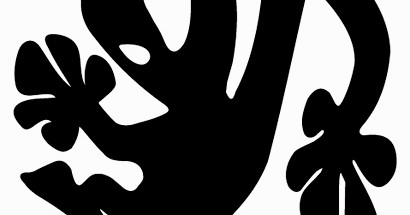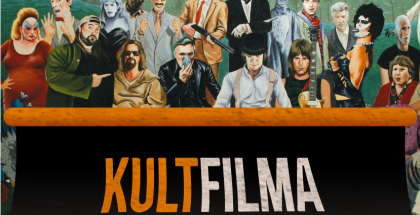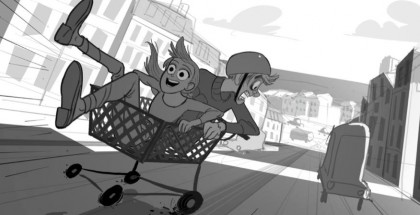The Limits of Control: A Postmodern Interactive Narrative in Film
The Limits of Control: A Postmodern Interactive Narrative in Film
“Use your imagination and your skills” because “Everything is subjective”. These two entry lines would be the guide in the attempt to deconstruct and understand the narrative structure in Jim Jarmusch’s 2001 film – The Limits of Control. In addition, this will be an attempt to understand the representation of an artistically constructed thriller, embedded with highly concentrated importance to the visual representation, music, as well as the central focus given to the subjective dialogs, or monologues – both through their intentional absence, subjectivity and rarity of their appearance.
In the film, the protagonist is immediately introduced through a motif, which will further keep a solid presence throughout the story, but will remain an enigmatic one and of secondary importance in comparison to the more central ones that will be encountered in the progression of the plot. The specific physical morning training sessions, which appear as a form of meditation (resembling tai chi movements), create the entry signal that we are dealing with a very subjective topic and with a disciplined main – unnamed – character. It continues with the first encounter where the coding and metaphorical messages are ‘addressed’ to the protagonist, who by encoding them, is supposed to be instructed in his mission. The narrative is an interactive discovery of meanings through the hints made available in repetitive messages – be they visual or verbal – which nevertheless are never imposing a strict narrative, rather serve as reoccurring motifs with different culture-specific connotations (Wolpers 42-43).
There appear to be two types of encrypted messages taking place between the characters. The first ones being verbal and used as code for establishing a safe environment for transmission of information – such as “You don’t speak Spanish right?” or “Two coffees in separate cups” – and the other ones are the written messages that give the impression of functioning as essential information in the realization of the mission. The model is always the same, and it always contains an exchange of matchboxes, mostly containing encrypted text messages, but in one case also pearls, which could be calculated as a payment for the information and involving gender ascription through the line “Diamonds are girl’s best friend”. The central importance of these messages is confirmed through the act of eating the actual letters containing encrypted text and numeric messages after reading them. On the other hand, the verbal conversations are coded with subjectivity and encrypted meanings that the personages confidently understand, but are left to be reinterpreted independently by the public. The level of interactivity needed in creating meaning is higher than the one we would expect in other – less subjective – films.
The verbally expressed messages appear to be generalized metaphoric ideas, open for interpretation, including fundamental philosophical formulas, easily ‘personifiable’ by the public, representing a postmodern specificity in creating a narrative discourse. Each encounter is a message and a guidance for the next encounter and each of them holds a different sub-motif.
The construction of events evolves accidentally, once again leaving an open door for interpretations, questioning if the whole organization of this mission is led by instinctive coordination, affected by some abstract order of events, which in a way are directed through subliminal subjective messages and emotional tendency to follow the plan, as one of the messages puts it, by using the imagination.
Another hiding motif, is the presence of intruders as portrayed through the line of “among us there are those who are not among us”, and two cases of ongoing hidden battles between the opposing sides are taking place with two women in the film, “the Blonde” and “the Nude”. The prescription of her fate is exactly the description of the film, which “the Blonde” herself suggests in the meeting with the protagonist and this could as well be interpreted as a self-reflection and an acceptance of her sacrifice for the cause. The death of the other woman in the film is represented as a murder through the detail of cracks on the eyeglasses.
Furthermore, a detail to note is the film’s centralized importance to the non-verbal audiovisual representations of signs, ideas, and messages, and we could assign to it an equal importance as the actual verbal part involved in constructing the motifs. They come in messages through the architectural representations, for instance, the tower, and also the various artworks and musical pieces. They might as well represent an aesthetic companion to the evolution of the main narrative, not only containing messages, but also being used as partnering commodity. However, a structural model of narrative seems to be evident, which appears as an exchange, a play between audiovisual frames and encounters with reduced communication, which almost every time occurs between two characters. With this model, can be extracted a numerological sign which is not only present with the encounters of the main characters, but also found through the random breaks, such as the respite scenery of two man holding a bath, or two people randomly talking in the street, along with another major sign of this duality, which is the two coffees. These visual breaks are important in the interactive/independent construction of the narrative, as they retain their universality in interpretation and even impose superiority, on the otherwise very abstract and subjective dialogs that also represent ideas on generalities.
The phrase “Use your imagination and your skills” comes as a general suggestion as many other messages throughout the story that are represented in a parallel play of sending signs and messages to the public. This assumption goes in line with director’s commentaries on his initial intentions in creating a film made to generate meanings by the public, as reported in the interview (Q&A Jarmusch). The ability to interpret, the independence to decide, and the supposed nonexistence of structures and how they could be easily reinvented and imagined in itself, stands as a very postmodern approach to the narrative structure. Another such hint is given on the encounter with “the Mexican” at the village: “sometimes the reflection is far more present than the thing reflected”,a saying that perhaps is another push for finding out that the topoi revolves around the supposed mission, appearing as the only expectable objective assignment and outcome, but is never specified. This pointing might as well be encountered through the other abstract claims, such as “Reality is arbitrary”.
Although we notice the signs of his presence from the beginning of the film, the identity of the main antagonist is finally exposed at the end. One of the signs is the case when the black suited agents appear in the airport, and later reappearing in few other instances, like in the case of the disappearance of ‘the blonde’ or the death of ‘the nude’, or by the different messages of warnings. He appears to be the personification of the greedy elitist existence shaped in the character of a non-empathic powerful globalist oligarch. Here, one could not avoid the globally affecting sociopolitical implications that this detail contains, which goes in line with the diversely chosen characters. The idea behind this representation is the encounter between the imaginatively constructed assassination mission of one group and intended against another power center, residing in the hands of a limited number of rich individuals who seem to have a strict belief in their exclusivity – as the end scene puts it “you people don’t know nothing”. With this, the interpretations to these signs and the mission itself as being ideological, political and philosophical are enforced. Thus, with the mission completed and the message sent to the viewer, the anonymous hero character gets back to his usual habitat, wearing off his missionary/professional outfit and getting on with his ‘natural’ everyday life representation. An early sign to the aforementioned division we encounter in the beginning: the instance of two women with necklaces as opposed to the idealist and philosophically fueled missionaries. This encounter appears to be in line with definition of the most complex category of events in the narrative, or as Doležel (1978) categorizes it the “interactional motif” category (Doležel 51-52).
It would not be a wrong guess if we spot the center of the plot structure positioned in the final scene, but undoubtedly, another type of topos is actually present and driving the narrative, although not portrayed and represented as the ultimate and obvious goal of the events. In fact, it seems that the topos of the film is a new form of interactivity, namely the interactivity of the narrative, which concentrates in the importance of the public, to which the development of the story is completely dependent on, thus offering possibilities for constructing meanings.
The commonplace of the story is the mission and the expectation for the eventual culmination and resolution to the mystery. In the film, we’re driven throughout different motifs, which culminate in the only direct encounter of the protagonist and the antagonist at the final resolution, both being nameless personified representations. However, the conceptualization and the meaning-making out of it – as planned – is left for the interactive narrative experience of the public.
Works Cited
Wolpers, Theodor: “Recognizing and Classifying Literary Motifs. Introduction”. In: Thematics Reconsidered. 4–11.
Doležel, Lubomir: “Narrative Semantics and Motif Theory” Essays in Poetics. The Journal of the British Neo-Formalist Circle. 1978, vol. 3 (1), 47–56.
Jim Jarmusch joined Film Society of Lincoln Center’s Gavin Smith for a Q&A following a screening of The Limits of Control on April 30th, 2009
www.youtu.be/v62aGp0v64k
*Marrja e përmbajtjeve të plota apo pjesore të artikujve lejohet vetëm me shtimin e referencës për postimin origjinal në blog.



















